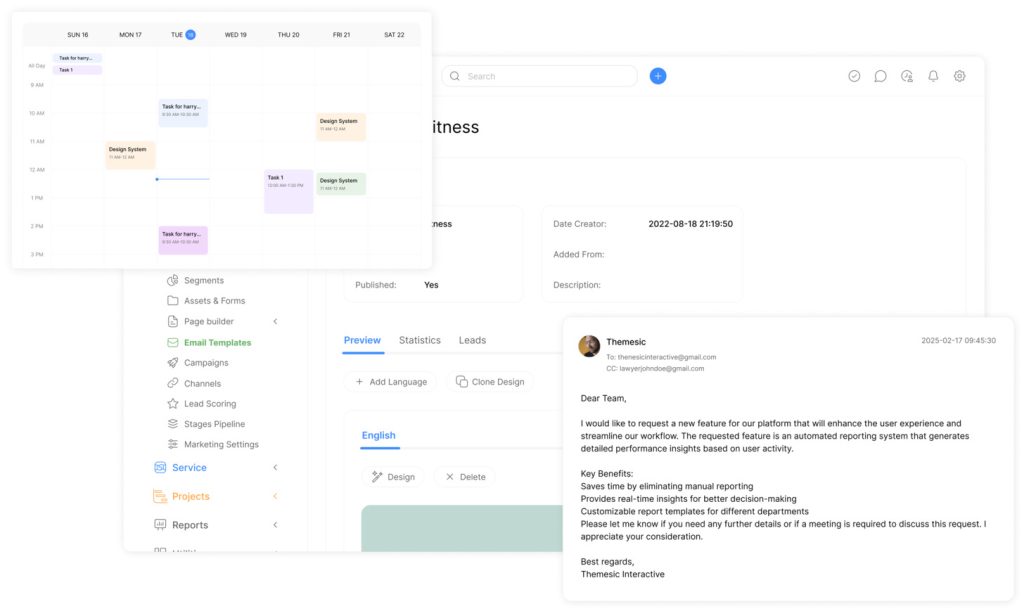Email Template Library: Boost Efficiency in Email Marketing

Modern marketing teams face constant pressure to deliver polished campaigns quickly, making an effective email template essential for efficiency. Pre-built design collections eliminate the need to start from scratch, offering tested solutions that work across devices. Platforms like Stripo provide 1,000+ professionally crafted layouts, each optimized for mobile screens and desktop clients through rigorous testing with tools like Email on Acid.
These resource hubs cater to diverse needs, from transactional confirmations to holiday promotions. Industry-specific options for sectors like finance or retail ensure communications align with brand standards. Seasonal designs for events like Mother’s Day or Back to School campaigns let teams deploy timely content without design delays.
Customization remains simple while maintaining visual consistency. Drag-and-drop editors allow quick adjustments, ensuring businesses preserve their identity while adapting messages. Integration with popular marketing platforms streamlines workflows, reducing production time by up to 65% according to industry reports.
Key Takeaways
- Pre-designed layouts cut campaign creation time by 50% or more
- Device-responsive designs guarantee proper display across all platforms
- Industry-specific options meet unique sector requirements
- Seasonal collections enable fast deployment of holiday campaigns
- Seamless software integration accelerates entire marketing workflows
Understanding the Email Template Library Advantage

Cutting-edge marketing operations thrive on resources that transform complex tasks into streamlined processes. Pre-built design systems eliminate repetitive groundwork while maintaining brand cohesion, letting teams prioritize message impact over structural logistics.
Key Benefits of Pre-Designed Layouts
Modern platforms accelerate campaign development through reusable components. Stripo’s Smart Elements generate product grids and promotional banners in minutes, with 40+ font options for visual customization. Modular architecture lets marketers save frequently used sections—like headers or footers—for instant reuse across projects.
This approach reduces errors by 47% compared to manual designs, according to martech analysts. Synchronization tools update all connected campaigns when core elements change, ensuring brand consistency during rebrands or seasonal shifts.
Improved Efficiency and Engagement
Professionally crafted frameworks incorporate engagement-tested layouts, including strategic white space and mobile-responsive grids. These designs boost click-through rates by placing CTAs in high-visibility zones while maintaining readability across devices.
Time-saving features extend beyond aesthetics. Automated modules cut content creation time by 60%, letting teams allocate resources to A/B testing and audience segmentation. The result? Campaigns that resonate faster, without compromising quality or brand standards.
Responsive Design and Mobile Optimization
Today’s audiences check messages across multiple screens, demanding flawless experiences. Platforms like Stripo address this challenge through device-responsive layouts that automatically reorganize content. These designs eliminate horizontal scrolling and formatting errors, maintaining engagement whether viewed on 4-inch smartphones or 27-inch monitors.
Adaptive Layouts for All Devices
Professionally built frameworks adjust content hierarchy based on screen size. A promotional banner might display horizontally on desktops but stack vertically on mobile for thumb-friendly navigation. Rigorous testing with tools like Email on Acid ensures elements render correctly across 90+ email clients and devices.
Mobile-first principles guide these systems, prioritizing the 67% of users who open messages on phones. Dynamic grids resize images proportionally, while touch-friendly buttons prevent misclicks. No separate versions needed – one layout adapts universally.
Customization Options for Mobile and Desktop
Marketers gain precise control over cross-device presentation. Hide non-essential elements on smaller screens or adjust font sizes for readability. Features include:
- Device-specific styling for buttons (wider on mobile)
- Custom spacing between containers
- Selective image visibility per platform
These tweaks preserve brand identity while optimizing for each user’s context. A retail campaign might emphasize product carousels on desktops but simplify to single-column displays on mobile – all within the same design file.
Streamlined Email Creation Process

Forward-thinking teams now bridge design creativity with technical precision through unified editing systems. Platforms like Stripo merge intuitive interfaces with developer-grade tools, letting users create polished campaigns without starting from scratch. This dual approach supports rapid iteration while maintaining brand consistency across all communications.
Visual Simplicity Meets Code Precision
The drag-and-drop editor enables marketers to arrange pre-built elements like text blocks or images in minutes. Users position content visually while the system generates clean HTML/CSS code automatically. For advanced adjustments, teams access the HTML code editor without leaving the workspace – ideal for embedding videos or interactive elements.
| Feature | Visual Editor | Code Editor |
|---|---|---|
| Ease of Use | No technical skills required | Requires coding knowledge |
| Customization Depth | Basic layout adjustments | Full design control |
| Best For | Quick campaign assembly | Advanced functionality |
This hybrid system reduces production time by 58% compared to traditional methods. Teams maintain creative flow by editing visuals and code in the same environment. CSS modifications apply inline automatically, ensuring consistent rendering across devices.
Seasoned developers appreciate the ability to hand-code complex interactions, while marketing specialists focus on message optimization. Real-time previews eliminate guesswork, showing exactly how elements appear on mobile and desktop screens.
Integrating Email Templates with Popular Email Platforms
Effective communication systems thrive when tools adapt to existing workflows. Leading solutions embed design resources directly into widely used platforms through browser extensions and native add-ons. Users access polished layouts within familiar interfaces like Gmail or Outlook, eliminating app-switching delays during campaign creation.
Gmail Integration and Add-On Features
The Google Workspace integration places professional frameworks one click away. Chrome extensions inject pre-built layouts into the composition interface, maintaining workflow continuity. Teams deploy sales pitches or service updates faster using standardized designs that align with brand guidelines.
Outlook Compatibility and Extensions
Microsoft users benefit from parallel functionality through dedicated browser tools. The Outlook extension mirrors Gmail’s efficiency, supporting Office 365 and legacy accounts alike. Enterprise organizations maintain visual consistency across departments using shared resources optimized for Microsoft’s ecosystem.
Cross-platform libraries work seamlessly across major providers like Gmail and Outlook. Import capabilities from marketing tools ensure brand continuity while reducing redundant design work. Collaborative features let teams centralize approved messaging frameworks, ensuring alignment across all outreach channels.
Optimize Your Marketing with Email Template Library

Strategic marketing demands tools that accelerate outreach without compromising quality. Pre-built campaign frameworks empower teams to launch polished promotions 3x faster than manual designs, according to Martech Alliance research. These systems embed conversion-focused layouts with heatmap-optimized CTA placement, boosting engagement by 22% on average.
Campaign efficiency improves through reusable structures tailored to specific goals. A product launch layout might prioritize visual storytelling, while retention-focused designs emphasize loyalty incentives. Teams maintain brand cohesion across channels while adapting messages for local markets or seasonal trends.
| Approach | Template-Driven | Manual Creation |
|---|---|---|
| Setup Time | 15-30 minutes | 4+ hours |
| Brand Consistency | Auto-enforced | Manual checks |
| Personalization Features | Dynamic fields | Limited |
| Cross-Platform Performance | Pre-tested | Variable |
Dynamic content integration lets marketers auto-adjust promotions based on subscriber behavior. A travel agency could showcase beach resorts to warm-climate contacts while highlighting ski packages to cold-weather recipients – all from one template.
Time-sensitive campaigns benefit most from this strategy. When competitors shift pricing, teams deploy counter-promotions within hours using pre-approved designs. Performance tracking becomes more accurate with standardized layouts, enabling clearer A/B test comparisons.
Advanced Customization and Personalization Techniques
Personalized communication now drives customer expectations, requiring marketers to deliver tailored experiences at scale. Advanced tools transform generic messages into dynamic interactions that adapt to individual preferences in real time.
Dynamic Content and Real-Time Updates
Modern platforms like Stripo enable live content adjustments that refresh when subscribers open messages. A welcome sequence can showcase recent blog posts automatically, while eCommerce brands display current inventory levels through AMP-enabled designs. This approach ensures every email delivers timely information without manual updates.
Real-time features extend to interactive elements. Retailers embed live product carousels, while service providers integrate appointment booking widgets. These dynamic components boost engagement by 34% compared to static layouts, according to recent case studies.
Utilizing Merge Tags for Personalized Messaging
Sophisticated tagging systems let teams customize messages beyond basic name insertion. Marketers reference purchase history or browsing behavior to craft content that addresses specific customer needs. A travel agency might highlight beach resorts to warm-climate contacts while suggesting ski packages to others.
Key advantages include:
- Behavior-triggered product recommendations
- Location-based offer adjustments
- Loyalty-tier-specific incentives
These techniques help businesses maintain brand consistency while ensuring every email feels individually crafted. Automated personalization scales outreach without sacrificing relevance, turning generic campaigns into meaningful customer conversations.
Ensuring Consistency with Branded Email Templates

Maintaining visual coherence across multiple campaigns challenges even experienced marketing teams. Stripo’s automated Brand Guidelines kits solve this by converting approved layouts into enforceable style standards. These digital rulebooks capture every design element – from color codes to logo placement – ensuring uniformity across departments.
Automated Style Enforcement
The system generates comprehensive brand manuals with one click, locking in approved fonts and visual structures. Email-safe typefaces render correctly on all devices, while decorative fonts appear only in image-based headers. This approach eliminates guesswork for new team members while giving veterans creative guardrails.
Sales teams benefit from pre-built frameworks that align promotions with core identity markers. Automated checks flag deviations from color schemes or spacing rules before campaigns launch. Real-time feedback mechanisms help maintain quality standards as organizations scale outreach efforts.
Centralized asset libraries ensure every newsletter and sales collateral uses current logos and approved imagery. Marketing leads report 38% faster onboarding for designers using these structured guidelines. The result? Unified brand presentation that builds recognition without stifling campaign creativity.
Conclusion
Businesses seeking rapid campaign deployment find game-changing solutions in pre-built design systems. These frameworks slash production timelines by 50% while delivering polished, on-brand communications. Teams bypass repetitive tasks and focus on crafting messages that convert.
Consistency remains crucial for audience recognition. Professionally designed layouts maintain visual standards across sales outreach and promotional drives. Responsive grids adapt content for flawless mobile viewing – no coding expertise required.
Event-specific promotions shine with ready-made structures. Holiday sales or product launches deploy faster using tested formats. Freemium options let organizations evaluate layouts before committing resources.
The true value lies in scalability. Companies reuse core structures across campaigns, updating only relevant sections. This approach preserves brand identity while allowing quick adaptations to market shifts. When efficiency meets impact, businesses achieve more with less effort.

